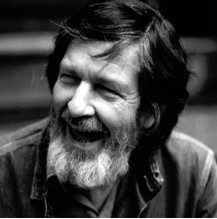
Today is John Cage’s 100th birthday, or it would be if he were still with us. Cage was an experimental composer, musician, essayist, and poet. He’s probably best known for his composition 4’33”, which consists of four minutes and thirty-three seconds of silence (or, if you prefer, the deliberate absence of performance and the presence of the ambient noise of life.)
But to my people, he’s known as a mushroom guy. Cage started—or technically, revived, as it had existed briefly before—the New York Mycological Society, a collection of mycophiles that hosts regular mushroom walks around the city and state. NYMS turns 50 this year, and so in celebration of its birthday and Cage’s centennial, they’re hosting a Cagestravaganza at Cooper Union this Saturday.
Festivities including a gallery show with Cage's mushroom book, a specimen display, and mushroom art; a multimedia Cagean simultaneity; and a pre-performance dinner.To learn more about Cage and his mushrooms, I spoke with Mycological Society secretary Paul Sadowski.
AF: I wondered if you would talk to me a bit about how John Cage was involved with the re-starting of the Mycological Society.
PS: What happened was he was teaching—he made a deal with the New School. They wanted him to teach a music class, and he said he would if he could also teach mushroom identification class. So they agreed to let him do it, and he, along with Guy Nearing, a very accomplished naturalist, taught this class. I think they started teaching it in 1959 and it ran three years, becoming ever more popular to a point where they decided that they really needed to set up a structure that could handle all the details of running a larger group. At the gallery show, we have the catalog with the listing in it, from the New School, and also Cage’s account of how the whole thing got started.
AF: And also the mushroom book, right? [The book is more complicated than just a book, and hard to display: it’s a portfolio containing 10 duo folios. On one side of each folio are Cage’s poems and illustrations in several different weights of lithographic crayons. On the other side are different mushroom botanical drawings.
Each folio also contains a loose sheet of transparency overlay printed with the technical description of a mushroom.]
PS: The mushroom book is the star of the show, actually! But to display it requires two sets, so that you could see everything, because the way it is, it’s printed on both sides. So the John Cage Trust owns three of these sets and they decided that since we were so keen on displaying the whole thing, they would split up the folios, actually tear them asunder. It will be a total of about 27 frames of these lithographs and their accompanying transparencies. A few of the transparencies are going to be actually framed with the lithographs as an overlay, which is what Cage had intended. Though the transparencies tend to obfuscate the mushroom, it sort of approximates the experience one has hunting mushrooms in the woods.
AF: I saw a quotation that Gary Lincoff had posted on the NYMS Facebook page about Cage finding some unidentified Agaricus mushrooms and just serving them and hoping no one got sick.
PS: Yeah, he was kind of adventurous. You know, that sort of thing happens. That happened kind of recently. about three years ago, we had a walk in Tallman Park—it’s a great walk, it’s well-attended, and it’s a great place for mushrooms. We kept finding very sturdy mushrooms, not Agaricus, but sturdy like that, that had white gills. It’s called Clitocybe robusta, and nobody really knew about its edibility until a couple of people tried some. They lived to tell the tale, so a few more people ate them and lived to tell the tale. [ED NOTE: DO NOT DO THIS!!!!]
AF: Do you know anything about how Cage became interested in mushrooms in the first place?
PS: I think he always had an interest. First of all, he was chow hound, he was always interested in food. I think because of his innate curiosity—he was a very smart guy—he had a tremendous curiosity and capacity for learning. He was living somewhere on the West Coast, I think it was Carmel, California. He was eating mushrooms, and all he was eating were mushrooms, and he had a dinner invitation one day and he found he hardly had the strength to walk through town. So he kind of learned the hard way that mushrooms don’t really have much nutritional value. That’s back in the 30's, during the Depression.
Where he really got into it, it seems, was when he moved up to Stony Point. He had a friend by the name of Paul Williams, who was an architect. Williams bought some land with the intention of converting into an artist’s colony. I don’t want to say a utopia, but a collective. When they bought the land all there was was a farm house and Cage lived there with four or five people. Up to that point Cage had been living with Merce in an apartment, basically alone, and there he was living in a house with all those people. So he used to go out for a little solitude and there were a lot of mushrooms growing up there. That’s where I think he really got into it. Being in this area, he was near Guy Nearing, and Guy Nearing was really his mushroom guru.
The gallery show is being hosted at Cooper Union and is open to the public (for free!) September 7-8. Tickets for Saturday’s performance, a multimedia realization of Cage’s 49 Waltzes for the Five Boroughs, start at $20 ($5 for students) and go up to $200, which includes a pre-show dinner prepared by Eugenia Bone. Buy them here, get more info here. You should go!
























